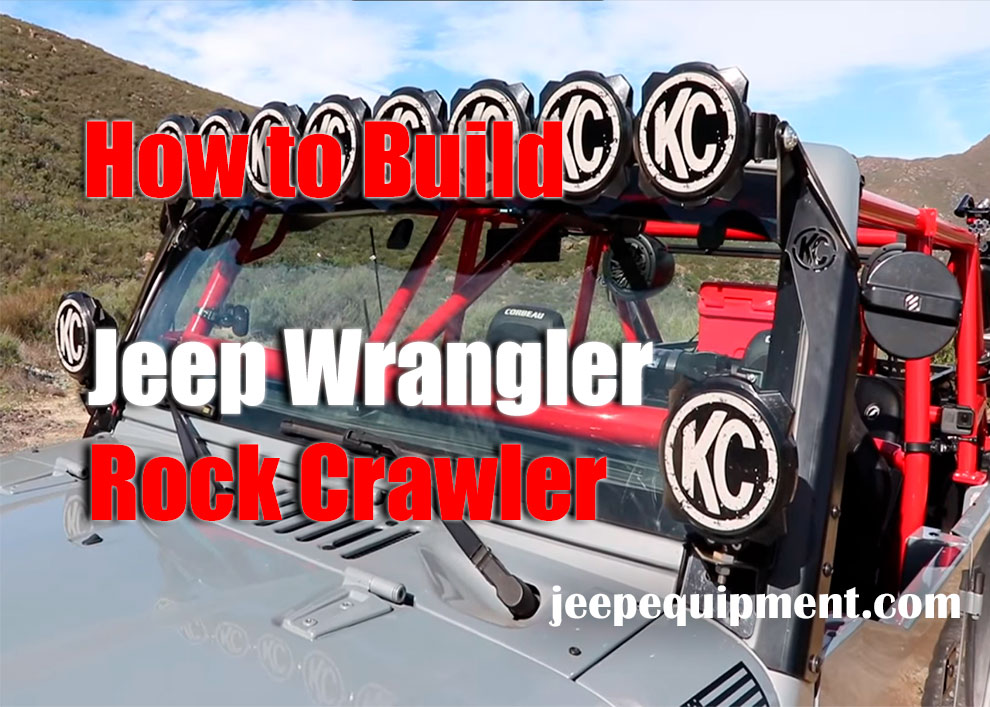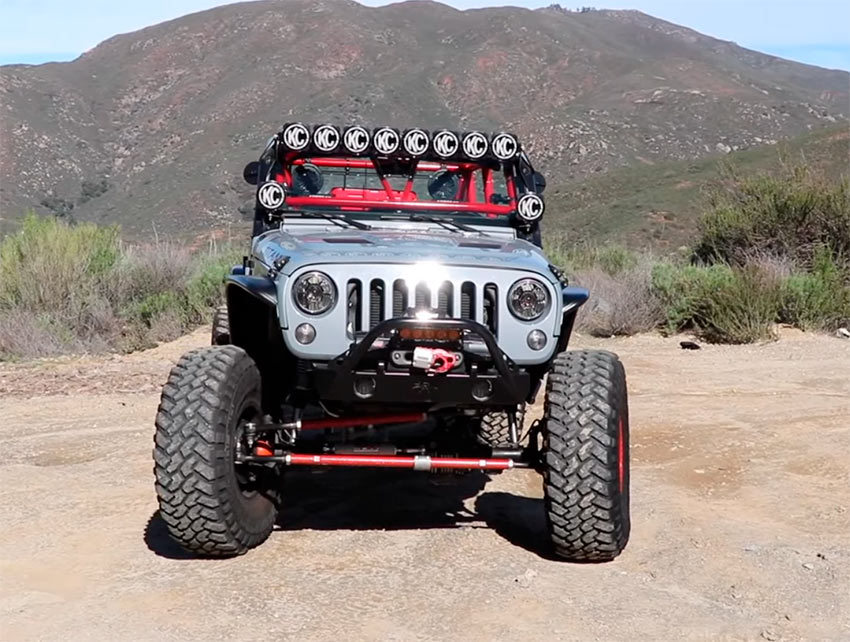Admit it: you’ve been driving around in your Jeep acting all civilized, but something doesn’t feel right. There’s a voice telling you to go off-roading and to conquer the local mountains, forests, and deserts! I know exactly what you’re going through, and in this post, I’ll help you build a rock crawler out of your Jeep Wrangler. It can be an intimidating task, a challenge if you will, but it’s not that hard, to be honest.
The very first Jeep SUVs saw the light of day back in the 40s (during WWII) and were meant to be military vehicles. Over the years, they proved to be highly durable, reliable, and overall capable. As for the coil-spring-type suspension, the company’s engineers created it more than 2 decades ago (in 1997, to be exact). Thanks to the straight axles, Jeep’s SUVs are perfectly fit for rock crawling.
Today, we’ll be talking about suspension, lifting, off-road tires, wheels, ball joints, and a Steering Stabilizer for Jeep. Yes, we’ll be mostly dealing with gear/hardware that’s hidden underneath the vehicle. Now, after our manipulations, the steering, braking, and overall ride quality will significantly change, but that’s a part of the deal. So, let’s get right to it, and start building our rock-crawling Wrangler!
Learning Your Way around Suspension
More ground clearance – that’s our #1 goal. In other words, we need to “make way” for bigger tires. But how do you achieve that? With a Lift Kit for Jeep Wrangler, of course! And what is a lift kit, exactly? It consists of (upper and lower) control arms that elevate the jeep. My advice to you: don’t go cheap with the arms: I know we all like to save some bucks on customization, but I still recommend paying an extra buck for the lift kit.
For the rock crawler to truly work, we’ll need three inches of lift or more. The bad news is – all the other mechanical components of your Jeep will have to “get used to” this new, enhanced clearance. I’m talking about the coil springs, shocks, and maybe even drive shafts (but these aren’t critical). Steering correction will be required as well – we’ll talk about that later on.
Working With the Wheels and Tires
One of the best things about Jeep SUVs – they can “accommodate” much bigger tires on an average kit than most rivaling four-wheelers. Still, if you’re planning on 35-inch tires (or bigger), you’ll definitely need a lift. The Jeep’s Rims, in contrast, should be as small as possible (to improve overall performance). When it comes to backspacing, stock rims aren’t your best choice. You need a third-party set that lets the wheels “breathe”.
Otherwise, you’ll end up in a situation where the tires are constantly scratching against the inner fender frame (which is bad news). As for the material, aluminum and steel are the go-to choices for wheels. Have you heard about bead lock wheels, by any chance? They run at a much lower air pressure than factory wheels and achieve greater traction with the road.
The Beadlock Wheels for Jeep JK increase the jeep’s footprint significantly without compromising on the ride quality or anything else. They usually come with a two-year finish warranty and boast incredible durability. And what about the tire size, you might ask? What is the optimal size? Well, there’s no such thing: we’ve got 35, 37, 39, and 40-inch tires, and they are all off-road friendly. For rock crawling, though, I’d recommend something like 39-40 inches.
One of the most important things you’ll need to do is use a deflator to “air down” the tires. When you drop the pressure, that gives you more control over the jeep and improves traction – exactly what a rock climber needs. In my experience, 10 to 13 PSI (pounds per square inch) is a good place to start. Even if you’re rocking the Best Off-road Tires for Jeep Wrangler, they won’t be very effective until you use a tire deflator to set the right PSI.
Fixing the Steering
Once you lift the jeep and add a new set of big-bad tires, the jeep’s steering will change. To get things back to normal, you’ll need geometry correction brackets. These will not only restore stock steering but improve the ride quality as well. It might also be a good idea to purchase new ball joints. With all the updates that we’ve discussed, only the Best Ball Joins for Jeep JK, JL, TJ dampen the side-to-side movement of the wheels. If you’ve been dealing with some bump-steer/flighty steering issues, after a lift, everything will get even worse. But remember: a stabilizer only deals with the symptoms – it doesn’t truly fix anything. Therefore, there’s no need in using a double-stabilizer setup unless the situation really requires it.
The Brakes
The Wrangler’s factory brakes are quite alright for regular commutes. They can even do a decent job with 35-inch tires, but anything bigger than that will need a more advanced kit. The stock pads, rotors, and calibers won’t be able to stop larger tires as effectively as smaller ones. Yes, I’m talking about the stopping distance: you don’t want to go off-roading with a bad set of brakes that won’t have your back in an emergency.
Axle Shafts and Drive Shafts
These are the go-to components for any driveline improvements. For a 2.5-inch lift, the stock gear will be more than ok. For something higher, consider buying a brand-new set (like chromoly axles). The U-joints come first; next, you can buy new bolts, nuts, gussets, and sleeves. And let’s not forget about lockers: they will ensure an even traction distribution, which is imperative for successful rock crawling.
By ensuring the two wheels on the axle move at the same speed and with the same amount of force, the locking differentials help the Jeep make it up the toughest hills. They aren’t very expensive or hard to install, but you will need some experience and extra tools. The Best Differential Lockers for Jeep are noise-free and perform equally well on and off the road.
Body Customizations
Everything we discussed to this point was all mechanical, hidden from the naked eyes. So, let’s talk a bit about body modifications. Say, the rear bumper can beef up the Jeep and make it look more masculine. On top of that, the best ones usually come with a built-in winch, add extra clearance, protect the Jeep in rough situations, and can hold a spare tire.
Armor fenders perform a similar role: they look good and reinforce the Jeep. And then we have lightning options to consider. There are dozens of different LED systems for the Jeeps/other SUVs; personally, I like those fancy roof lights that can lighten up the darkest night. Fans of crawling should also think about installing a set of Rock Sliders. As the name suggests, they are mounted to the chassis and protect the Jeep’s bottom from severe damage.
Always Have Spares!
That’s right: even if you’re a seasoned pro, without some spares, you will be stuck in the middle of nowhere with no means to start the Jeep. Spare hubs, axle shafts, a U-joint, and a front/rear driveline are a must. A winch will also come in handy. An extra set of nuts, bolts, air deflators, and all the other “little guys” will easily fit in one’s pocket. And don’t forget about all the important fluids!
Conclusion
And that’s about it, my dear friends! I could say that rock crawling isn’t rocket science, but as far as Jeep customizations go, this one is pretty complicated. First of all, you need to know what you’re doing to get good results. Secondly, all the third-party gear will cost you a lot, even if you go with low-budget options. As for the installation, it would be best if a mechanic buddy of yours could join the project to smooth the edges, so to speak.
On the other hand, if you know your way around control arms, wheels, and steering stabilizers, everything will be much easier. I wanted to make this guide as simple and down-to-Earth as possible for the beginners to understand it. But, even a pro can learn a trick or two. Even though I covered the basics, there’s some fundamental stuff there that you might want to check out. Don’t hesitate to reach out to me in the comments!


Add Comment